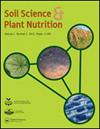Predicting arbuscular mycorrhizal fungal colonization of soybean in farmers’ fields by using infection unit density
IF 1.8
4区 农林科学
Q3 ENVIRONMENTAL SCIENCES
引用次数: 0
Abstract
ABSTRACT Estimating arbuscular mycorrhizal (AM) fungal activity to colonize crop root before cultivation is prerequisite for effective utilization of their functions which enhance growth and yield of the plant especially under low fertilizer input. We have hypothesized that the infection unit (IU) density formed on test plant roots grown for short period (12 days) with soil sampled from soybean production fields would be an effective indicator to predict AM fungal colonization intensity to the plant. In order to test this hypothesis, three-year farmland survey was conducted, in which soil samples before sowing soybean and the plant root samples at third trifoliate (V3) and full bloom (R2) stage were collected from farmers’ fields in two regions in Hokkaido, Iwamizawa and Tokachi. For each sampling spot, IU density was determined by using test plants, and intensity of AM fungal colonization of soybean root was measured. Before pursuing field survey, laboratory experiments were conducted to find out proper soil storage condition that keeps IU density unchanged while handling many soil samples. Our results indicated that IU density was almost comparable to the original value after six-month storage if soil samples were kept in a refrigerator, although storing at ambient temperature significantly decreased the measurement. Air drying also had negative impact on IU density. According to the field survey, IU densities determined using field soil were positively and significantly correlated with AM fungal colonization of soybean roots at both V3 and R2 stages. Differences in climate, soil type, and style of agriculture between Iwamizawa and Tokachi seemed to have little effect on IU density-AM fungal colonization relationship. Other than IU density, soil pH and soil penetration resistance at 10 cm depth were selected as significant explanatory variables for predicting AM fungal colonization by multiple regression analysis. However, IU density was the most influential factor among three. Therefore, IU density is recognized as an effective measure to evaluate AM fungal colonizing activity in field soil.利用侵染单位密度预测大豆丛枝菌根真菌在农户田间的定植
摘要在作物栽培前对丛枝菌根(AM)真菌定殖的活性进行评估是有效利用其促进作物生长和产量功能的前提,特别是在低肥料投入条件下。我们假设,在大豆生产田取样的土壤中短时间(12天)生长的试验植物根系上形成的感染单位(IU)密度将是预测AM真菌对植物定殖强度的有效指标。为了验证这一假设,我们在北海道岩见泽和德胜两个地区的农民田间进行了为期三年的农田调查,收集了大豆播种前的土壤样品和第三三叶期(V3)和盛花期(R2)的根系样品。在每个采样点,利用试验植物测定IU密度,测定AM真菌在大豆根部的定殖强度。在进行实地调查之前,通过室内实验,寻找在处理大量土壤样品时保持IU密度不变的合适土壤储存条件。我们的研究结果表明,如果土壤样品在冰箱中保存6个月后,IU密度几乎与原始值相当,尽管在环境温度下储存会显著降低测量值。空气干燥对维生素d密度也有负面影响。根据田间调查,田间土壤测定的IU密度与大豆根系中AM真菌在V3期和R2期的定殖均呈显著正相关。岩见泽和德立的气候、土壤类型和农业方式的差异似乎对IU密度- am真菌定殖关系影响不大。除IU密度外,10 cm深度土壤pH和土壤穿透阻力作为预测AM真菌定植的重要解释变量,采用多元回归分析。然而,IU密度是三者中影响最大的因素。因此,IU密度被认为是评价AM真菌在田间土壤定殖活性的有效指标。
本文章由计算机程序翻译,如有差异,请以英文原文为准。
求助全文
约1分钟内获得全文
求助全文
来源期刊

Soil Science and Plant Nutrition
农林科学-农艺学
CiteScore
4.80
自引率
15.00%
发文量
56
审稿时长
18-36 weeks
期刊介绍:
Soil Science and Plant Nutrition is the official English journal of the Japanese Society of Soil Science and Plant Nutrition (JSSSPN), and publishes original research and reviews in soil physics, chemistry and mineralogy; soil biology; plant nutrition; soil genesis, classification and survey; soil fertility; fertilizers and soil amendments; environment; socio cultural soil science. The Journal publishes full length papers, short papers, and reviews.
 求助内容:
求助内容: 应助结果提醒方式:
应助结果提醒方式:


